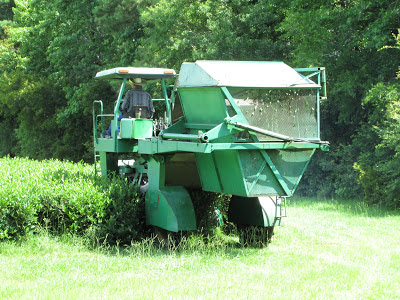Last week Mark and I had the opportunity to go with 120 other farmers to Charleston South Carolina . It was a wonderful time! We enjoyed making several new friends and seeing how they farm in the south. This post is our ag tours. I plan to do another with our "touristy" stuff soon.
Our first stop was two brothers that farmed cotton, peanuts, corn & soybeans together. The picture above is cotton. We asked what it cost to rent land and they said around $35 per acre. They average around 130 bushels of corn per acre and 150 is good. They don't pay much for cash rent however, spraying 10-12 passes on a crop adds up in a hurry!
This is their cotton picker. Two 750 lb bales of cotton to the acre is their break even crop.
Bert showing us is peanut field. Peanuts is their money maker. They thrive in poorer, sandy soil where the other crops don't.
A sideways view of the peanut field. These are Virginia peanuts, the kind you roast and eat out of the shell at baseball games, not the peanut butter kind.
Next farm was Jerry's, he grows 1400 acres of tobacco, which is huge for tobacco! They also have strawberry's, butter beans and several other veggies that they grow and sell at their farm stand. We missed the butter bean harvest by one day. Jerry's wife told us they have people as far away as Florida come to buy butter beans.
This is the tobacco flower that gets removed so the plants energy all goes to the leaves. They have crews of migrant workers come in and do this work. Cash rent prices for tobacco fields are higher, up to $125 per acre. Since tobacco is labor intensive and they are always in the field working with large crews of people, landowners charge more for rent.
These are the tobacco harvesters. They make four passes harvesting. They start picking the bottom 25% of the plant leaves, which are the lower quality ones, then the next go around the middle 50%, finally the last top 25% which is the higher quality leaves.
After the leaves are harvested they dry in these "mobile home" looking boxes.
This is their greenhouse of little tobacco plants.
The dried tobacco leaves have sand on them so they go into a big drum to turn and get cleaned off.
The last farm of the day was a tomato farm. They raise 50 acres of tomatoes! The big thing in tomatoes right now is heirloom tomatoes. They have 74 varieties of heirloom tomatoes. Mark and I appreciated how each of the farmers we visited thanked the Lord for their farm. Greg especially, he told us how their business has been blessed since they closed on Sundays. Check them out here.
Sorting cherry tomatoes after picking. Much of their labor is done by migrant workers.
They were packaging cherry tomatoes while we where there.
Fun photo opportunity outside their store. :) Our last stop for the day was the USDA vegetable lab. I didn't get any pictures because we didn't get to see anything they were doing, just heard about their projects in a meeting room.
The next morning we headed to American' s only tea plantation, The Charleston Tea Plantation. We toured the factory and took the trolley for a ride around the tea fields.
The tea going through the 20 hour plant to package process.
Rows of tea plants. These bushes live up to 600 years and are naturally disease and pest resistant. Deer also don't like the bitter taste of the leaves. They aren't considered organic because they have to use a commercial fertilizer. It would take 1.5 feet of chicken manure on the ground to get enough nitrogen and they didn't think tourists would enjoy that. :)
A very slow moving tea picker. This machine was custom made and only goes 1.5 mph. It was fun listen to our group of farmers brainstorm about how they could make it faster and more efficient. They only harvest the top 3 inches of leaves for tea making.
We enjoyed a picnic under some beautiful old trees. I wish I had these in my yard, although we would probably have more broken arms! :)






















No comments:
Post a Comment